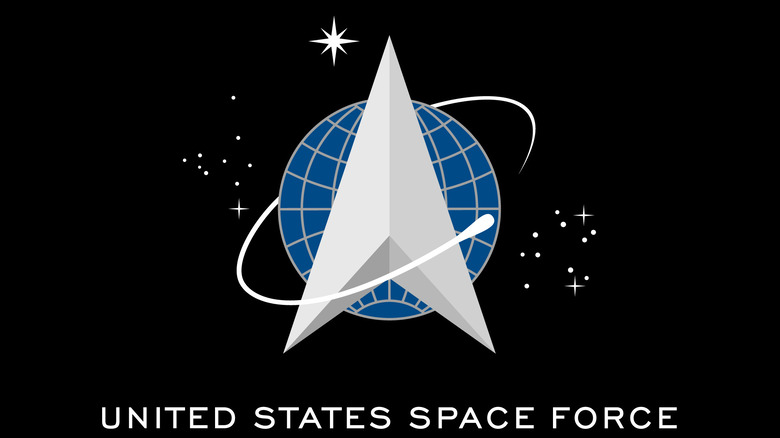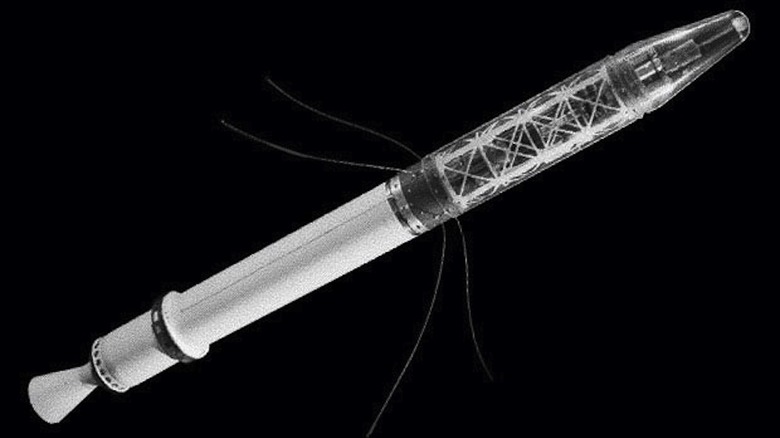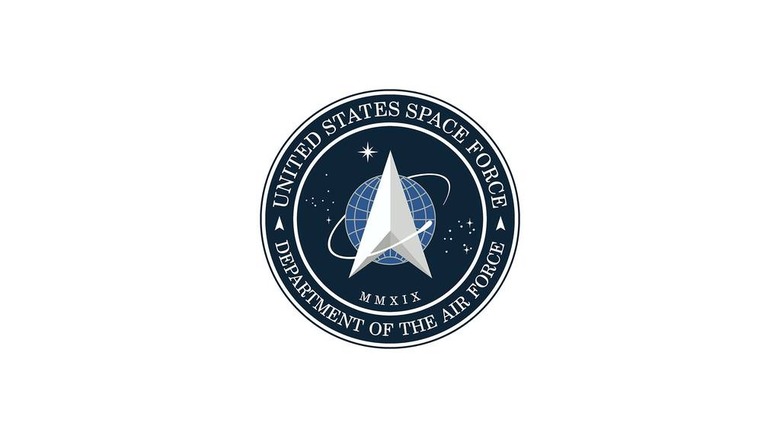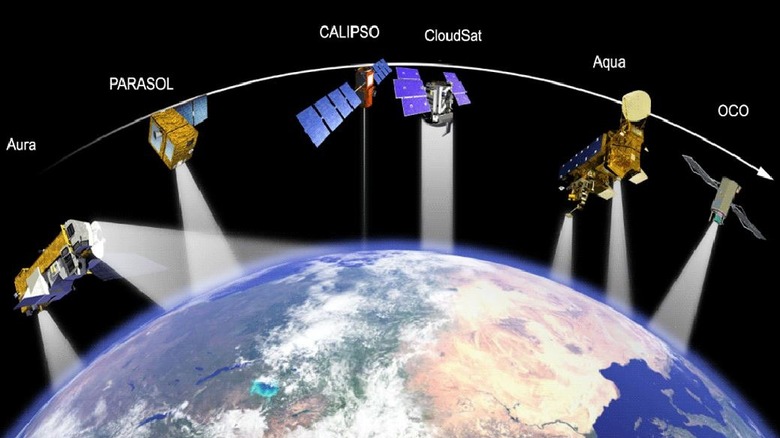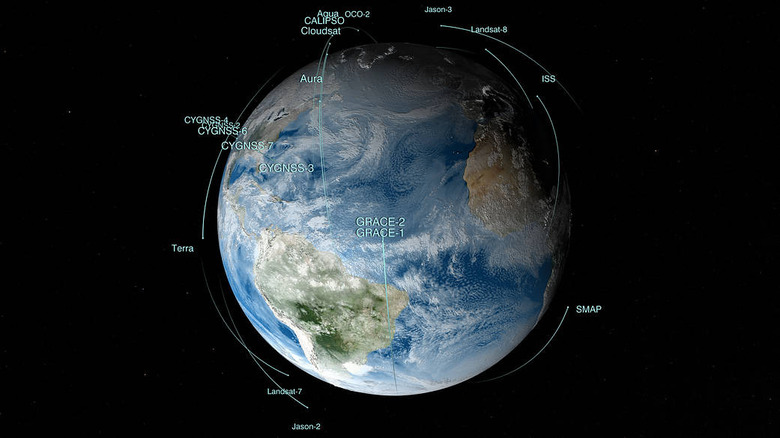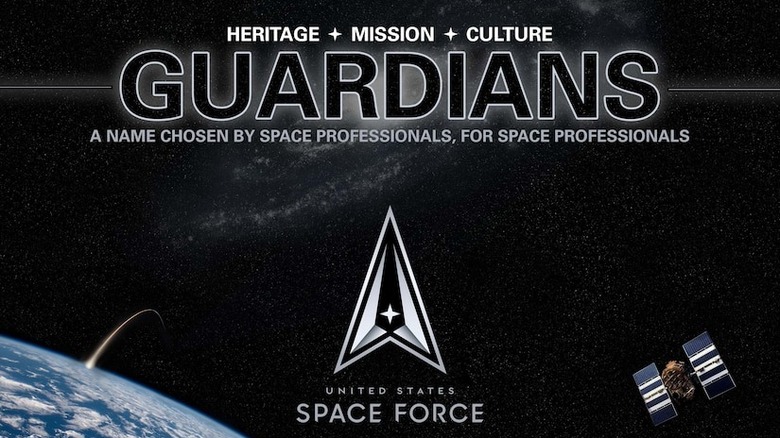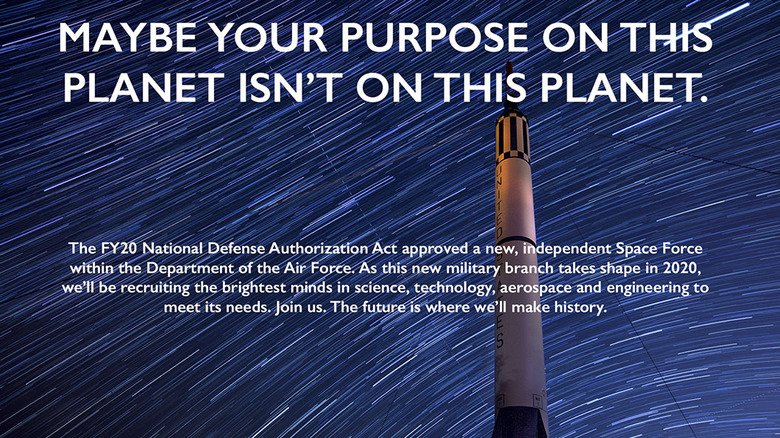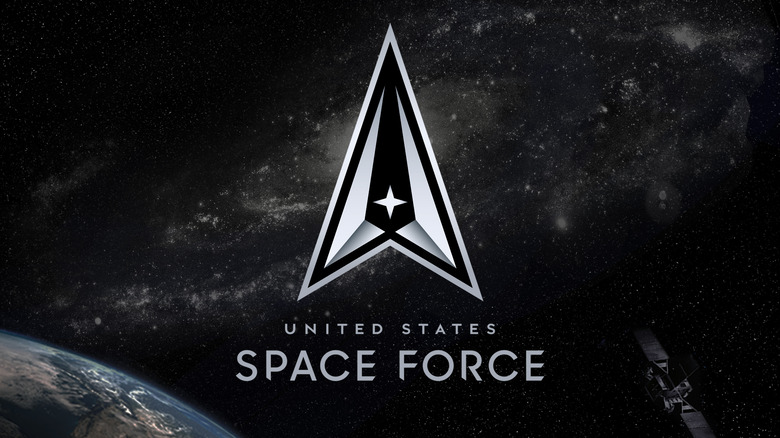Everything You Need To Know About The United States Space Force
If you say the words Space Force, you're likely to get a number of reactions and, perhaps the most common is confusion. That confusion can manifest in a variety of ways, but it mostly comes down to a lack of clarity around what Space Force is, if it's needed, and what it hopes to achieve.
It isn't often that new military branches are created. The last time it happened was almost a century ago when the Air Force was created in 1947 (via Air Force Historical Support Division). So, it stands to reason that there's a period of acclimation during which both the organization itself and the public wrap their heads around what it is.
Many have responded to the still-developing Space Force with humor, at least in part because it sounds like something ripped from the pages of a science fiction story. So much so that it's been the inspiration for a farcical television series starring Steve Carrell. We can't help but wonder if there might have been similar reactions to an Air Force only a few decades after the airplane was invented.
History will determine the legacy and utility of the Space Force, but in the meantime, we're going to break down everything you need to know about the United States Space Force.
Before Space Force
Even before the creation of the Air Force as an independent branch of the military, the United States' armed forces were looking into space as the next potential field for military operations. While space might seem like a logical extension of the air, it wasn't immediately clear which branch should or would take charge of the emerging domain.
In the years after World War II the Army and the Navy, in addition to the newly christened Air Force, were wrestling for control of military operations in space. In fact, the first United States satellite to reach orbit — Explorer 1 — was launched by the Army in 1958. Shortly thereafter, the Naval Research Laboratory launched Vanguard 1, which remains in orbit today and is the world's oldest still orbiting artificial satellite.
After the Army and Navy's successes in launching satellites, the Air Force doubled down on its right to maintain ownership over military space and in the early '60s, President Kennedy honored that request, giving the Air Force primary dominion among military organizations (via JFK Library).
In 1982, control over space was further formalized with the creation of Air Force Space Command, later US Space Command. That organization, still a part of the Air Force, would maintain military control over space for most of the next four decades.
The founding of Space Force
Over recent decades human activities in space have only increased. Most of what makes headlines are ostensibly civilian activities like those which take place aboard the International Space Station, but military activities in space have continued apace. In fact, in addition to helping build the ISS, the U.S. Space Shuttle program ferried an unknown amount of military hardware into space.
Moreover, peer space agencies in Russia and China have continued to develop military capabilities in space (via Foreign Policy). Now, more than ever before, space has become a potential battlefield. The idea for a branch of the U.S. military focused entirely on space isn't new. It has been floated several times before, but government leaders always felt the time wasn't right.
That all changed in 2018 when the White House announced plans to finally create a new branch of the military which would come to be known as Space Force. On December 20, 2019, the U.S. Space Force was created as a part of the National Defense Authorization Act, a $738 billion annual military spending budget.
At the time, it wasn't entirely clear what the role of the new branch would be, but it was known it would largely takeover activities in space previously handled by Air Force Space Command.
Space Force's mission
When the world first heard about the Space Force, it conjured images of military astronauts armed with futuristic weapons or piloting warfighting spaceships. We can't make any predictions about what the future of space-based warfare might be like, but the reality of the current Space Force is much more grounded.
At present, the U.S. Space Force has two primary objectives. The first is protecting military assets already in orbit, largely military satellites. The second is developing a strategy for the utilization of space in earthly combat. That second goal is massively dependent on the first. Much of what the armed forces do on the ground, in the oceans, or in the air today relies on information provided by orbiting satellites.
To that end, Space Force maintains open lines of communication with the other branches of the U.S. military, providing insight and intel from orbiting assets. All of these activities, at least at the moment, are carried out by satellite operators stationed on the ground.
How can Space Force achieve its objectives?
The popular vision of military combat mostly involves the Army with its marching soldiers and rolling tanks, the Navy with its submarines and aircraft carriers, and the Air Force with its dogfighting jets and bomber planes. These are all essentially Earth-based activities taking place in the three familiar domains of ground, air, and sea. Yet so much of what takes place on the modern battlefield relies on information gathered from space.
Satellites provide global positioning systems (GPS) which are convenient for finding your way to the grocery store but are critical when navigating through a featureless desert. They allow for instantaneous communication anywhere in the world and provide information about potential targets.
While the United States currently has the largest satellite fleet in the world, losing those assets would bring military operations to a standstill, not to mention the civilian cost of losing everything satellites provide even during peacetime.
Other nations, mainly Russia and China, have developed or are developing anti-satellite weapons that could be a threat. Space Force is charged with protecting U.S. satellites from those sorts of challenges, something it can do in a couple of ways.
Satellites could be reinforced such that attacks are less likely to disable them and additional satellites could be launched in vast numbers, so that the loss of any one satellite won't significantly reduce the overall capability. Precisely how Space Force moves forward, remains to be seen.
The groups inside Space Force
Space Force is building a new organizational infrastructure out of the Air Force organization it inherited. In the Air Force, units are broken up into wings, underneath specific commands. Space Force has adopted a similar philosophy.
There are three commands within Space Force: Space Operations Command, Space Systems Command, and Space Training and Readiness Command. Instead of wings, each of those commands has a number of deltas rolling up to them. Those deltas have the following objectives.
Space Delta 2 is responsible for Space Domain Awareness, a focus on defensive and potential offensive activities in space. Space Delta 3 is responsible for Space Electromagnetic Warfare, systems that could render space assets of adversaries unusable. Space Delta 4 uses three constellations of orbiting satellites as well as ground-based radar to provide missile warnings.
Space Delta 5 is Command & Control, it plans and executes space operations. Space Delta 6 handles Cyber Operations. Because control of orbiting satellites happens remotely, it is responsible for maintaining the systems which allow that to happen.
Space Delta 7 is Intelligence, Surveillance, and Reconnaissance. It is essentially the eyes and ears feeding into every other delta, alerting them to possible threats. Space Delta 8 has a focus on satellite communication, including position, navigation, and timing using the military's GPS system. Space Delta 9 is the closest thing we have to an actual star wars-type group. It is in charge of orbital warfare and has its own space plane.
Space Training and Readiness – STARCOM
As of August 23, 2021, Space Force stood up the last of its three command groups, known as Space Training and Readiness Command, or STARCOM, responsible for the initial education of new recruits, which are known as guardians.
You might have noticed Space Delta 1 missing from the above list — that's because the deltas listed above all fall under the first two command structures. Space Delta 1 is training, and falls under STARCOM, along with deltas 10 through 13. Once through initial training, the additional deltas provide specialized training including enhanced education, testing, wargames, and more (via Space Force).
Because STARCOM is so new, it is still figuring out precisely what the training regimen will entail, but recently announced new training exercises with appropriately space-themed names like Polaris Hammer and Black Skies.
Those exercises will happen sometime in 2022, at which point Space Force will assess their effectiveness and make any necessary adjustments as the programs move forward.
What has Space Force done so far?
Space Force turned two years old at the end of 2021 and the first 18 months were largely organizational and staffing up. Building an organization of this scope is a big job and has taken some time to, well, get off the ground.
So far, most of the work carried out within the new organization has been taking over existing space capabilities from the Army and Navy. Those activities have also included the transfer of existing personnel between services.
Of course, any actual military operations carried out in space would likely be classified and, being off-planet, necessarily outside of the public view.
However, those kinds of operations could begin soon. Space Force's Chief of Space Operations General John W. "Jay" Raymond has mentioned potentially offensive systems deployed by both Russia and China, and defending against those will likely be early objectives if they haven't begun already.
These first years of the organization's existence have been moderately quiet, something which has fed the sorts of conspiracy theories that were due to swirl around a military organization operating in space. As the cosmic dust settles and Space Force finds its feet, we're likely to hear about a lot more activity.
Who can join Space Force?
When Space Force first started, the easiest way to get in on the action was to already be a member of the Air Force and in a relevant position. The first people to join Space Force were members of the Air Force who were transferred upon its creation. Roughly 16,000 people were transferred from the Air Force to Space Force when it was first spun up.
In fact, the first Chief of Space Operations John W. "Jay" Raymond was previously the Commander of U.S. Space Command for the Air Force.
At present, Space Force is not accepting any additional inter-service transfers, though that may change in the future. If you're not already a member of the armed forces, you can apply as long as you're between the ages of 17 and 39 and have a high school diploma or equivalent.
There are also civilian roles available for folks wanting to get into the space arena without joining the armed forces.
How Space Force is different from NASA
There is definitely some similarity between the two organizations. NASA and the United States military have maintained strong ties since the very beginning of space exploration. As previously mentioned, some of the first ventures into space, even those which were scientific in nature, were carried out by one military branch or another.
Moreover, a significant portion of NASA astronauts are recruited from the various military branches or else had retired from military service. That's in large part because prior flight time is a benefit and joining the military is one of the most efficient ways to get it. Although, while serving as an astronaut for NASA, even military members are acting in a civilian capacity.
NASA and Space Force obviously share a locality, both operating in space, but their primary mission and objectives are different. Space Force is concerned with protecting and defending the United States and its military assets in space while NASA is concerned with science, exploration, and education.
That said, sometimes the two objectives overlap. In December of 2020, astronaut Mike Hopkins transferred from the Air Force to Space Force while orbiting inside the International Space Station.
Space Force could embark into virtual space
As virtual environments are becoming more ubiquitous, many companies and organizations are looking to build their own platforms, and Space Force is considering getting in on the action.
The term "metaverse" has made headlines of late, owing primarily to the relatively new virtual space owned by Meta, previously Facebook. In truth, however, a metaverse hails from the Neal Stephenson novel "Snow Crash" and refers to any digital space within which people can interact with one another. If you've ever played a video game, particularly one which involves multiple players from different locations, then you've been inside a metaverse.
At the AFCEA Space Force IT conference held on February 10, 2022, Lisa Costa, chief technology and innovation officer for Space Force, mentioned the possibility of building a metaverse for use by members of the Space Force.
The ability to experience an environment in three dimensions is useful for a lot of different jobs but it might be particularly useful for people tasked with operating in an environment they're not able to visit. Because Space Force's are enacted on the ground but take place in space, a virtual representation could give operators a clearer real-time understanding of the field of play.
Fighting one of space's biggest enemies: junk
Attacks from foreign enemies aren't the only threat to the United States' assets in space. In fact, they may not even be the biggest one. At present, there are more than 27,000 pieces of space junk floating around in orbit with more added all the time.
All of that debris amounts to a considerable threat both to satellites and crewed missions in space. The International Space Station has already been struck by one piece of debris and has had to outmaneuver several others.
Space Force has indicated a desire to clean up Earth's orbit in a measure to protect our assets and ability to continue to have military, commercial, and civilian activities in space. The organization's technology division, known as SpaceWERX, companies planning to partner with private companies to develop technologies capable of capturing space debris and moving it out of harm's way.
Depending on the size of the debris and its location, that might entail simply adjusting its orbit such that it's no longer on a dangerous path. It also might mean pushing it closer to Earth so that it eventually burns up in the atmosphere.
So, what is Space Force?
At present, Space Force isn't largely different from its predecessor organization, the Air Force Space Command, or other space-based military arms from the Army or Navy. It has largely been a reorganization of existing capabilities under a unified structure.
Space Force maintains a focus on protecting and enhancing the United States' military hardware in orbit, from the ground, something which has been ongoing since the space race began. Its creation was less a response to a drastic change in military strategy in space, as much as it was a natural evolution of growing activities in space, not only by the United States but all over the world.
Space Force endeavors to prevent wars occurring in space, more than it hopes to carry out military activities in space, and that's in line with the international agreements we've made. Its major objective is to ensure space remains the free and open domain it is today, a resource and destination for all of humanity to explore.
What ISN'T Space Force?
You can put aside visions of X-wing fighters and tanks on the Moon. While it's true that one astronaut did transfer to Space Force while in orbit, and the branch has space plane capabilities, Space Force isn't in the business of sending armed guardians into space to fight battles in microgravity.
Furthermore, unless there are huge innovations in technology or classified activities we're not yet privy to, it isn't building laser weapons, photon torpedoes, or death stars. And it isn't sending battalions into the inky black depths of space to fight the bug menace from Klendathu.
Space Force isn't NASA, though it's likely it will continue to maintain the same good relationship with the civilian organization as other military space divisions have in the past. For now, at least, if you want time on a spaceship, your best bet is to hitch your star to NASA's wagon.
Space Force also isn't a joke, even if its existence makes for good comedy fodder. Our lives are highly dependent on space and there's reason to believe that will continue to be increasingly true.
